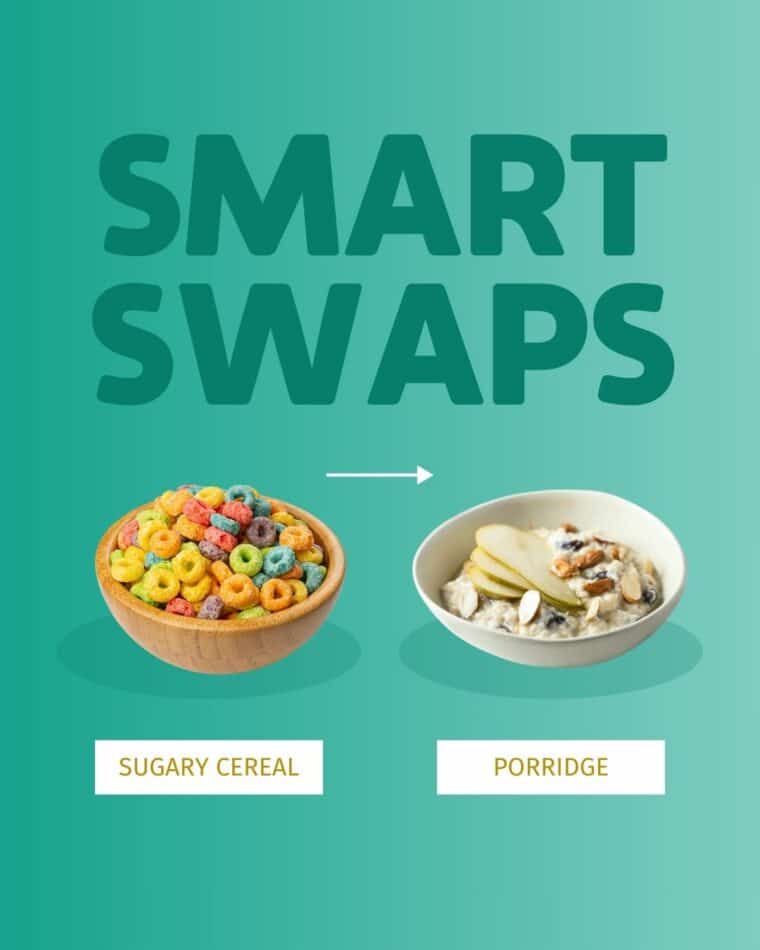The Alchemist’s Pantry: Mastering the Art of Smart Swaps for a Healthier You
In the quiet heart of every home, nestled behind cabinet doors and tucked away in cool, dark corners, lies a realm of immense power: the kitchen pantry. Often overlooked, frequently taken for granted, this collection of everyday staples holds the key not just to sustenance, but to vitality, energy, and long-term well-being. For the discerning individual, the pantry isn’t merely a storage space; it’s a laboratory, a canvas, and a testament to the transformative potential of conscious choice.
This is the story of Smart Swaps – a culinary alchemy that empowers us to trade common kitchen staples for healthier, more nutrient-dense alternatives. It’s a narrative not of deprivation or drastic overhauls, but of subtle, strategic shifts that, over time, rewrite our relationship with food and profoundly impact our health. For the knowledgeable audience, those already attuned to the nuances of nutrition, this journey offers a deeper dive into why these swaps matter, how they work, and the ripple effect they create in our daily lives.
The Guiding Principles of Culinary Transformation
Before we delve into specific swaps, let’s establish the philosophy that underpins this transformative approach. Smart Swaps are not about fleeting diet trends; they are about cultivating a sustainable lifestyle rooted in:
- Nutrient Density: Prioritizing foods that pack the most vitamins, minerals, antioxidants, and fiber per calorie. We’re moving away from "empty calories" towards "nutrient powerhouses."
- Whole Foods First: Emphasizing ingredients in their most natural, unprocessed state. The closer a food is to its source, the more likely it is to retain its inherent goodness.
- Mindful Ingredient Reading: Developing a keen eye for labels, understanding hidden sugars, unhealthy fats, and artificial additives. Knowledge is power, especially when navigating the modern food landscape.
- Balancing Macronutrients: Recognizing the importance of healthy fats, complex carbohydrates, and lean proteins in maintaining stable energy levels, satiety, and overall bodily function.
- Inflammation Reduction: Choosing ingredients that actively combat systemic inflammation, a silent perpetrator behind many chronic diseases.
- Gut Health Support: Incorporating foods that nourish our microbiome, recognizing its pivotal role in digestion, immunity, and even mood.
Armed with these principles, let us unlock the hidden potential within our pantries, one smart swap at a time.
The Foundation: Fats and Oils – The Silent Architects of Health
Fats have long been demonized, but the truth is, the right fats are essential for hormone production, nutrient absorption, cell function, and sustained energy. The problem lies in the prevalence of highly processed, inflammatory vegetable oils.
The Common Culprits: Canola oil, corn oil, soybean oil, sunflower oil, safflower oil.
These oils are often high in omega-6 fatty acids, and while omega-6s are essential, a disproportionate ratio to omega-3s (common in Western diets) can promote inflammation. They are also often heavily processed, refined, bleached, and deodorized, stripping them of beneficial compounds and potentially introducing harmful ones.
The Smart Swaps:
-
Extra Virgin Olive Oil (EVOO): A cornerstone of the Mediterranean diet, EVOO is rich in monounsaturated fats (MUFAs) and powerful antioxidants like polyphenols. It’s excellent for dressings, drizzling over finished dishes, and light sautéing. Its smoke point is moderate, so save it for lower-heat cooking.
- Why it’s better: Anti-inflammatory, heart-healthy, rich in vitamins E and K.
- Culinary tip: Look for cold-pressed, dark bottles to preserve its integrity. Use liberally on salads, roasted vegetables, or as a bread dip.
-
Avocado Oil: With a remarkably high smoke point (around 520°F or 270°C), avocado oil is the unsung hero for high-heat cooking like searing, stir-frying, and roasting. It’s also rich in MUFAs and vitamin E, with a neutral flavor profile that won’t overpower your dishes.
- Why it’s better: Versatile, stable under heat, good source of healthy fats.
- Culinary tip: A fantastic all-purpose cooking oil, it can replace most vegetable oils in any recipe without altering taste.
-
Coconut Oil (Unrefined/Virgin): While higher in saturated fat, the medium-chain triglycerides (MCTs) in coconut oil are metabolized differently, providing a quick energy source and potentially supporting brain health. Unrefined virgin coconut oil retains its distinct tropical aroma and flavor, which can be delightful in certain dishes and baking.
- Why it’s better: Contains MCTs, antimicrobial properties, adds unique flavor.
- Culinary tip: Ideal for Asian-inspired dishes, baking, or adding a subtle tropical note to smoothies. Use refined coconut oil for neutral flavor and higher heat applications.
-
Ghee (Clarified Butter): For those who tolerate dairy but seek a lactose and casein-free option, ghee is a flavorful revelation. It’s butter cooked down to remove water and milk solids, leaving behind pure butterfat. Ghee has a high smoke point (485°F or 250°C) and a rich, nutty flavor.
- Why it’s better: High smoke point, rich flavor, contains fat-soluble vitamins (A, E, K2), often better tolerated by those with dairy sensitivities.
- Culinary tip: Excellent for sautéing, roasting, and adding depth to curries or even drizzling over popcorn.
The Core: Grains and Carbohydrates – Fueling the Body, Stabilizing the Mind
Carbohydrates are our primary energy source, but the type of carbohydrate makes all the difference. Refined grains, stripped of their bran and germ, offer quick energy spikes followed by crashes, and contribute little in terms of fiber and micronutrients.
The Common Culprits: White rice, white pasta, white bread, most breakfast cereals.
These refined grains have a high glycemic index, leading to rapid blood sugar increases. This can contribute to insulin resistance, weight gain, and energy fluctuations.
The Smart Swaps:
-
Whole Grains (Brown Rice, Quinoa, Farro, Steel-Cut Oats): These are the superstars of complex carbohydrates. They retain their bran (fiber), germ (nutrients like B vitamins, vitamin E, healthy fats), and endosperm (starch). Their fiber content slows down sugar absorption, providing sustained energy.
- Why it’s better: High in fiber, protein (especially quinoa), vitamins, and minerals. Supports gut health and blood sugar stability.
- Culinary tip:
- Brown rice: Nutty flavor, great as a side, in bowls, or stir-fries.
- Quinoa: A complete protein, incredibly versatile for salads, pilafs, or even breakfast.
- Farro: Chewy texture, perfect for hearty salads or risottos.
- Steel-cut oats: Superior to rolled oats for a slower energy release, ideal for a sustained morning fuel.
-
Legume-Based Pastas (Lentil, Chickpea, Black Bean): A game-changer for pasta lovers! These alternatives are made from 100% legumes, offering significantly more protein and fiber than traditional wheat pasta, with fewer net carbs.
- Why it’s better: High protein, high fiber, gluten-free (if needed), lower glycemic impact.
- Culinary tip: They hold up well to sauces and provide a satisfying texture. Be mindful of cooking times, as they can differ from wheat pasta.
-
Sprouted Grain Breads (Ezekiel Bread): Sprouting grains can unlock nutrients, make them easier to digest, and reduce anti-nutrients. These breads typically contain a blend of sprouted grains and legumes, offering a more complete amino acid profile.
- Why it’s better: Enhanced nutrient availability, higher protein/fiber than white bread, often lower glycemic.
- Culinary tip: Toasting enhances their flavor and texture. Great for sandwiches or avocado toast.
-
Cauliflower Rice/Vegetable Noodles: While not grains, these offer excellent low-carb, nutrient-dense alternatives for dishes traditionally featuring rice or pasta.
- Why it’s better: Very low in calories and carbs, high in vitamins, adds extra vegetables to your meal.
- Culinary tip: Use cauliflower rice in stir-fries, burrito bowls, or as a base for curries. Spiralize zucchini or sweet potato for "noodles" in pasta dishes.
The Sweet Spot: Natural Sweeteners – Indulgence with Integrity
Sugar is ubiquitous in the modern diet, often hidden in unexpected places. Excessive intake contributes to inflammation, weight gain, and a host of chronic health issues. The goal isn’t necessarily to eliminate sweetness entirely, but to choose smarter sources and consume them mindfully.
The Common Culprits: Refined white sugar, high-fructose corn syrup, artificial sweeteners (saccharin, aspartame, sucralose).
Refined sugars offer empty calories and cause rapid blood sugar spikes. Artificial sweeteners, while calorie-free, can disrupt gut microbiome and may perpetuate sugar cravings.
The Smart Swaps:
-
Maple Syrup (Pure, Grade A or B): A natural sweetener containing antioxidants and trace minerals like manganese and zinc. It has a distinct flavor that works wonderfully in baking, dressings, and drizzled over oatmeal or pancakes.
- Why it’s better: Contains antioxidants, lower glycemic index than white sugar, natural flavor.
- Culinary tip: Use in moderation. Great in homemade granola, marinades, or as a coffee sweetener.
-
Raw Honey (Local & Unpasteurized): More than just a sweetener, raw honey contains enzymes, pollen, and propolis, offering potential anti-inflammatory and antimicrobial benefits. Its glycemic index is still high, so moderation is key.
- Why it’s better: Antioxidant, anti-inflammatory, antimicrobial properties (when raw).
- Culinary tip: Ideal for teas, yogurt, or as a binder in energy balls. Local honey may help with seasonal allergies.
-
Dates & Date Sugar: Dates are whole foods, rich in fiber, potassium, and antioxidants. Date sugar is simply dried, pulverized dates, retaining all their fiber and nutrients.
- Why it’s better: Whole food source, high in fiber, vitamins, and minerals.
- Culinary tip: Use pitted dates to sweeten smoothies, energy bars, or as a natural caramel in desserts. Date sugar can be a 1:1 substitute for brown sugar in many recipes.
-
Stevia (Pure Extract) & Erythritol: For those seeking zero-calorie options, pure stevia extract (from the stevia plant) or erythritol (a sugar alcohol found naturally in some fruits) can be good alternatives. Ensure you’re choosing pure forms, not blends with added fillers.
- Why it’s better: Zero calorie, zero glycemic impact.
- Culinary tip: Use sparingly as they are much sweeter than sugar. Erythritol is excellent for baking as it doesn’t leave an aftertaste for many.
The Cream of the Crop: Dairy and Alternatives – Diverse Options for Diverse Needs
Dairy products are a staple for many, but sensitivities, ethical concerns, or a desire for plant-based options have led to a flourishing market of alternatives.
The Common Culprits: Conventional cow’s milk, highly processed cheese spreads, heavy cream.
For some, lactose intolerance or sensitivity to dairy proteins (casein) can cause digestive issues. Conventional dairy may also contain hormones and antibiotics.
The Smart Swaps:
-
Unsweetened Plant Milks (Almond, Oat, Soy, Coconut): The variety is endless! Choose unsweetened versions to avoid added sugars. Look for brands fortified with calcium and vitamin D.
- Why it’s better: Lactose-free, cholesterol-free, often lower in calories (depending on type), suitable for vegans.
- Culinary tip:
- Almond milk: Light flavor, great in smoothies, coffee.
- Oat milk: Creamy texture, excellent for lattes and baking.
- Soy milk: High in protein, good for cooking and baking.
- Coconut milk (canned): Rich and creamy, perfect for curries, soups, or a dairy-free whipped topping.
-
Nutritional Yeast: A deactivated yeast with a savory, cheesy flavor profile. It’s a fantastic source of B vitamins (including B12, crucial for vegans) and can mimic cheese in many dishes.
- Why it’s better: High in B vitamins, complete protein, dairy-free cheese alternative.
- Culinary tip: Sprinkle over popcorn, roasted vegetables, or use to make dairy-free "cheese" sauces.
-
Cashew Cream/Tofu Sour Cream: For creamy sauces, dips, or sour cream alternatives, blended cashews or silken tofu can achieve remarkable richness and texture without dairy.
- Why it’s better: Plant-based, customizable flavor, adds healthy fats (cashews) or protein (tofu).
- Culinary tip: Soak cashews before blending for optimal creaminess. Season with lemon juice, apple cider vinegar, and herbs for a tangy profile.
The Zest: Condiments and Sauces – Flavor Boosts, Health Hazards Hidden
Condiments and sauces are often the unsung heroes of flavor, but they can also be stealthy carriers of added sugars, unhealthy oils, and excessive sodium.
The Common Culprits: Store-bought ketchup, mayonnaise, salad dressings, BBQ sauce, traditional soy sauce.
Many commercial options are laden with high-fructose corn syrup, refined vegetable oils, and artificial colors/preservatives.
The Smart Swaps:
-
Homemade Vinaigrettes & Dressings: Ditch the bottled versions! A simple base of extra virgin olive oil, apple cider vinegar or lemon juice, Dijon mustard, and herbs can create endless delicious, healthy dressings.
- Why it’s better: Control over ingredients, no unhealthy oils, sugars, or additives.
- Culinary tip: Experiment with different vinegars (balsamic, red wine), citrus, and fresh herbs. Make a batch and store in the fridge.
-
Avocado Oil Mayonnaise: A revolutionary swap! Made with avocado oil instead of soybean or canola oil, it offers a healthier fat profile without sacrificing taste or texture.
- Why it’s better: Healthy monounsaturated fats, no inflammatory oils.
- Culinary tip: Use just like regular mayo in sandwiches, dips, or as a base for creamy dressings.
-
Coconut Aminos: A fantastic soy-free, gluten-free alternative to soy sauce, made from the sap of coconut blossoms. It has a similar umami flavor but is lower in sodium and contains amino acids.
- Why it’s better: Lower sodium, soy-free, gluten-free, contains amino acids.
- Culinary tip: Perfect for stir-fries, marinades, sushi, or anywhere you’d use soy sauce.
-
Herbs, Spices, and Lemon/Lime Juice: The ultimate natural flavor enhancers! They add depth, complexity, and a wealth of antioxidants without any added sugars or unhealthy fats.
- Why it’s better: Nutrient-dense, anti-inflammatory, zero calories, adds vibrant flavor.
- Culinary tip: Learn to layer flavors with fresh and dried herbs. A squeeze of citrus can brighten almost any dish.
The Artisan’s Touch: Baking Ingredients – Reimagining Sweet Treats
Baking can be a joy, but traditional recipes often rely heavily on refined flour, white sugar, and unhealthy fats. Smart swaps can transform your baked goods into more nutritious, yet still delicious, treats.
The Common Culprits: All-purpose flour, white sugar, shortening, hydrogenated oils.
These ingredients contribute to empty calories, blood sugar spikes, and unhealthy trans fats.
The Smart Swaps:
-
Alternative Flours (Almond, Coconut, Whole Wheat Pastry, Oat):
- Almond Flour: Gluten-free, high in protein, healthy fats, and vitamin E. Creates a tender crumb.
- Coconut Flour: Gluten-free, extremely high in fiber, absorbs a lot of liquid.
- Whole Wheat Pastry Flour: A finer grind of whole wheat flour, offers more nutrients than all-purpose but still yields a tender texture.
- Oat Flour: Made from finely ground oats, gluten-free (if certified), high in fiber.
- Why it’s better: Increased protein, fiber, and micronutrients; often lower glycemic.
- Culinary tip: Baking with alternative flours often requires recipe adjustments due to varying absorbency and gluten content. Start with recipes specifically designed for these flours.
-
Natural Sweeteners (Applesauce, Mashed Banana, Date Puree): These not only sweeten but also add moisture and fiber, allowing you to reduce or eliminate added sugars.
- Why it’s better: Adds fiber, vitamins, and natural sweetness; reduces reliance on refined sugars.
- Culinary tip: Can often replace part of the fat in recipes as well.
-
Healthy Fats (Avocado Oil, Ghee, Applesauce/Yogurt): Replace butter or shortening with healthier fats or even moisture-rich alternatives.
- Why it’s better: Replaces inflammatory fats with beneficial ones; reduces saturated fat.
- Culinary tip: Avocado oil is neutral for baking. Ghee adds a rich, buttery flavor. Unsweetened applesauce or Greek yogurt can replace some fat while adding moisture.
The Extras: Snacks and Beverages – Mindful Munching and Hydration
Snacks and drinks are often where mindless consumption leads us astray. These seemingly small choices add up.
The Common Culprits: Chips, cookies, candy, soda, fruit juice (even 100% juice can be a sugar bomb).
These items typically offer little nutritional value, are high in sugar, unhealthy fats, and artificial ingredients.
The Smart Swaps:
-
Whole Food Snacks (Nuts, Seeds, Fresh Fruit, Veggie Sticks with Hummus, Hard-Boiled Eggs): Embrace nature’s convenience foods. They provide fiber, protein, healthy fats, and a wealth of vitamins and minerals.
- Why it’s better: Satisfying, nutrient-dense, sustained energy, no artificial ingredients.
- Culinary tip: Keep a variety on hand for quick grabs. Make your own trail mix with raw nuts, seeds, and dried fruit (no added sugar).
-
Sparkling Water with Fruit & Herbs: Elevate your hydration! Infuse plain or sparkling water with slices of lemon, lime, cucumber, berries, or sprigs of mint for a refreshing, sugar-free beverage.
- Why it’s better: Hydrating, sugar-free, refreshing, no artificial sweeteners or colors.
- Culinary tip: Prepare a large pitcher and keep it chilled in the fridge for easy access.
-
Herbal Teas & Green Tea: These offer a range of health benefits, from antioxidants to calming properties, without the sugar or caffeine jitters (if preferred).
- Why it’s better: Antioxidant-rich, hydrating, soothing, often caffeine-free.
- Culinary tip: Explore different varieties like peppermint, chamomile, ginger, or rooibos for different moods and benefits.
Beyond the Pantry: Embracing the Culinary Journey
The story of Smart Swaps is not just about isolated ingredients; it’s about a holistic shift in perspective. It’s about empowering ourselves to be the alchemists of our own kitchens, transforming ordinary ingredients into extraordinary nourishment.
- Start Small, Stay Consistent: The beauty of smart swaps lies in their incremental nature. You don’t need to overhaul your entire pantry overnight. Choose one or two swaps that feel manageable and integrate them consistently. Success breeds motivation.
- Experiment and Taste: Healthy eating should never be boring or bland. Embrace the adventure of new flavors and textures. Learn to roast vegetables with new spices, experiment with different grain bowls, and discover the joy of creating vibrant, wholesome meals.
- Listen to Your Body: Pay attention to how different foods make you feel. Do you have more sustained energy? Better digestion? Clearer skin? This biofeedback is your most valuable guide.
- Educate Yourself Continually: The world of nutrition is ever-evolving. Stay curious, read labels, and understand the impact of your choices. For the knowledgeable audience, this means diving deeper into research, understanding nutrient bioavailability, and appreciating the complex interplay of food components.
- Embrace Imperfection: There will be times when you eat less-than-ideal foods, and that’s perfectly okay. This journey is about progress, not perfection. The goal is to make healthier choices the default, not an occasional deviation.
The narrative of our health is written, day by day, in the choices we make in our kitchens. By consciously selecting ingredients, understanding their impact, and daring to experiment with healthier alternatives, we transform our pantries from mere storage spaces into powerful arsenals of well-being. The Smart Swap isn’t just a trade; it’s an investment – an investment in energy, longevity, and the profound joy of living a vibrant, well-nourished life. So, step into your pantry, embrace your inner alchemist, and begin your own delicious story of transformation.







